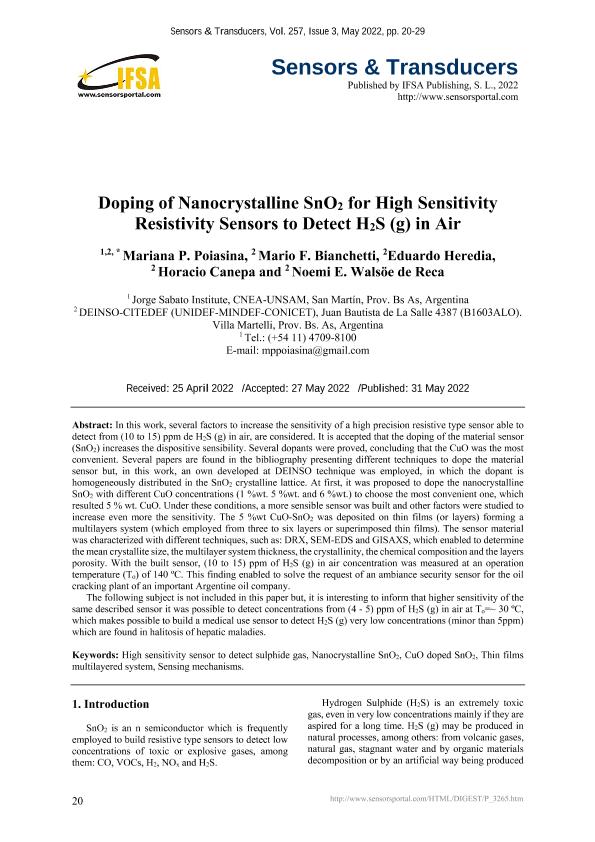Mostrar el registro sencillo del ítem
dc.contributor.author
Poiasina, Mariana Paola

dc.contributor.author
Bianchetti, Mario Fidel

dc.contributor.author
Heredia, Eduardo Armando

dc.contributor.author
Canepa, Horacio Ricardo

dc.contributor.author
Walsöe de Reca, Noemi E.
dc.date.available
2023-10-31T15:55:43Z
dc.date.issued
2022-05
dc.identifier.citation
Poiasina, Mariana Paola; Bianchetti, Mario Fidel; Heredia, Eduardo Armando; Canepa, Horacio Ricardo; Walsöe de Reca, Noemi E.; Doping of nanocrystalline SnO2 for high sensitivity resistivity sensors to detect H2S (g) in air; International Frequency Sensor Association; Sensors & Transducers; 257; 3; 5-2022; 20-29
dc.identifier.issn
2306-8515
dc.identifier.uri
http://hdl.handle.net/11336/216683
dc.description.abstract
In this work, several factors to increase the sensitivity of a high precision resistive type sensor able todetect from (10 to 15) ppm de H2S (g) in air, are considered. It is accepted that the doping of the material sensor (SnO2) increases the dispositive sensibility. Several dopants were proved, concluding that the CuO was the most convenient. Several papers are found in the bibliography presenting different techniques to dope the material sensor but, in this work, an own developed at DEINSO technique was employed, in which the dopant is homogeneously distributed in the SnO2 crystalline lattice. At first, it was proposed to dope the nanocrystalline SnO2 with different CuO concentrations (1 %wt. 5 %wt. and 6 %wt.) to choose the most convenient one, which resulted 5 % wt. CuO. Under these conditions, a more sensible sensor was built and other factors were studied to increase even more the sensitivity. The 5 %wt CuO-SnO2 was deposited on thin films (or layers) forming a multilayers system (which employed from three to six layers or superimposed thin films). The sensor material was characterized with different techniques, such as: DRX, SEM-EDS and GISAXS, which enabled to determinethe mean crystallite size, the multilayer system thickness, the crystallinity, the chemical composition and the layers porosity. With the built sensor, (10 to 15) ppm of H2S (g) in air concentration was measured at an operation temperature (To) of 140 ºC. This finding enabled to solve the request of an ambiance security sensor for the oil cracking plant of an important Argentine oil company.The following subject is not included in this paper but, it is interesting to inform that higher sensitivity of the same described sensor it was possible to detect concentrations from (4 - 5) ppm of H2S (g) in air at To=~ 30 ºC, which makes possible to build a medical use sensor to detect H2S (g) very low concentrations (minor than 5ppm) which are found in halitosis of hepatic maladies.
dc.format
application/pdf
dc.language.iso
eng
dc.publisher
International Frequency Sensor Association
dc.rights
info:eu-repo/semantics/openAccess
dc.rights.uri
https://creativecommons.org/licenses/by/2.5/ar/
dc.subject
HIGH SENSITIVITY SENSOR TO DETECT SULPHIDE GAS
dc.subject
NANOCRYSTALLINE SnO2
dc.subject
CuO DOPED SnO2
dc.subject
THIN FILMS MULTILAYERED SYSTEM
dc.subject.classification
Física de los Materiales Condensados

dc.subject.classification
Ciencias Físicas

dc.subject.classification
CIENCIAS NATURALES Y EXACTAS

dc.subject.classification
Cerámicos

dc.subject.classification
Ingeniería de los Materiales

dc.subject.classification
INGENIERÍAS Y TECNOLOGÍAS

dc.title
Doping of nanocrystalline SnO2 for high sensitivity resistivity sensors to detect H2S (g) in air
dc.type
info:eu-repo/semantics/article
dc.type
info:ar-repo/semantics/artículo
dc.type
info:eu-repo/semantics/publishedVersion
dc.date.updated
2023-10-30T17:57:49Z
dc.identifier.eissn
1726-5479
dc.journal.volume
257
dc.journal.number
3
dc.journal.pagination
20-29
dc.journal.pais
España

dc.journal.ciudad
Barcelona
dc.description.fil
Fil: Poiasina, Mariana Paola. Consejo Nacional de Investigaciones Científicas y Técnicas. Unidad de Investigación y Desarrollo Estratégico para la Defensa. Ministerio de Defensa. Unidad de Investigación y Desarrollo Estratégico para la Defensa; Argentina. Universidad Nacional de San Martín. Instituto Sabato; Argentina
dc.description.fil
Fil: Bianchetti, Mario Fidel. Consejo Nacional de Investigaciones Científicas y Técnicas. Unidad de Investigación y Desarrollo Estratégico para la Defensa. Ministerio de Defensa. Unidad de Investigación y Desarrollo Estratégico para la Defensa; Argentina
dc.description.fil
Fil: Heredia, Eduardo Armando. Consejo Nacional de Investigaciones Científicas y Técnicas. Unidad de Investigación y Desarrollo Estratégico para la Defensa. Ministerio de Defensa. Unidad de Investigación y Desarrollo Estratégico para la Defensa; Argentina
dc.description.fil
Fil: Canepa, Horacio Ricardo. Consejo Nacional de Investigaciones Científicas y Técnicas. Unidad de Investigación y Desarrollo Estratégico para la Defensa. Ministerio de Defensa. Unidad de Investigación y Desarrollo Estratégico para la Defensa; Argentina
dc.description.fil
Fil: Walsöe de Reca, Noemi E.. Consejo Nacional de Investigaciones Científicas y Técnicas. Unidad de Investigación y Desarrollo Estratégico para la Defensa. Ministerio de Defensa. Unidad de Investigación y Desarrollo Estratégico para la Defensa; Argentina
dc.journal.title
Sensors & Transducers
dc.relation.alternativeid
info:eu-repo/semantics/altIdentifier/url/https://www.sensorsportal.com/HTML/DIGEST/P_3265.htm
Archivos asociados
